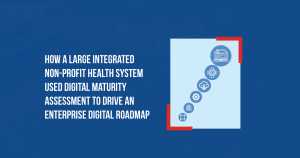Price of Entry or Corporate Strategy: How Pharma and Biotech Are Approaching Digital Health

Eliminating friction and creating value are driving investments in digital health in the pharma/ biotech sector. However, the value drivers are unique to the sector.
The high costs of drug discovery and commercialization, looming patent cliffs, and increasing regulatory pressure on drug pricing have created a perfect storm of margin and growth pressures on the pharma sector. In an apparent response to these pressures, M&A activity in pharma is back. This month, Bristol-Myers Squibb announced its $74 Billion acquisition of Celgene, and Eli Lilly did the same with its $8 Billion acquisition of Loxo. (At the recently concluded JP Morgan Healthcare Conference (JPM), the pharma/biotech sector’s biggest event of the year, Eli Lilly’s CEO indicated that conditions are ripe for an M & A uptick in 2019)
Acquisitions may be one way to stay on top of the marketplace changes; however, organic growth pressures remain. One way to address the challenge is through digital transformation. However, digital strategies within and across individual sub-sectors in healthcare may look different depending on what companies want to achieve at a corporate level, at a commercial level, and a technology level.
Digital in pharma: eliminating friction
Healthcare is on a mission to put the focus back on patients, improve engagement levels and achieve better healthcare outcomes, and reduce costs. Digital has become the price of entry into a future state implied by this renewed focus. Digital is also seen as a powerful tool for differentiation.
The most crucial purpose of a digital strategy may be the elimination of friction in the healthcare value chain. There are many areas that are ripe for improvement in pharma. One of them is to enable drug development by being able to measure things objectively to prove drug efficacy and demonstrate value. Another is to accelerate clinical trials through improved ways of recruiting and managing patients. Yet another is to develop digital therapeutic solutions to augment revenue streams.
Greg Silvesti, Head of Digital Health and Innovation at Abbvie, (a $28.2 billion company best known for its blockbuster drug Humira), says that pharma companies are dancing on a pinhead for differentiation today. He suggests that digital itself isn’t a strategy but an enabler to an overall strategy and a tool to unlock value. An overall digital strategy can be a combination of approaches depending on the strategic goals of the company. However, the key is building the approach with digital as an enabling technology for the overall strategy of the company.
The maturing of digital health and its challenges in pharma
The digital health space has matured in the last few years, attracting an eye-popping $8.1 billion in venture capital funding in 2018. There is no question that we are seeing a shift in how healthcare is being delivered through new digital health solutions. Telehealth is growing, as is remote monitoring. Vast amounts of increasingly diverse data sources from sensors and devices can now be aggregated and combined with traditional data sources such as electronic health records. Advanced analytical tools are now available to process these vast amounts of data in low-cost infrastructure on the cloud to develop and deliver insights at the point of care.
However, the digital health startup ecosystem has not made as much progress as expected. Many startups have failed, and many are unable to provide an exit to investors. Even big tech firms with huge investments in health cloud platforms are yet to make a significant impact. I have discussed some of the challenges for digital health startups in general including the Last Mile problem and the Law of Small Numbers in earlier columns here.
Succeeding in pharma requires digital health companies to recognize some unique principles and characteristics of the sector.
Data is not worth much
A few years back, everybody was fascinated by just the data that could come off of a smart sensor or wearable. The internet of things (IoT) was all the rage. What we have seen since is that there is not that much value in data; in addition to issues with data quality, sufficiency, and interoperability, simply being able to capture transactional metrics off of smart sensors and wearables does not create tremendous value, unless we are able to obtain actionable information by using advanced analytics such as artificial intelligence or AI.
Forget the widget, focus on the problem
For many startups, digital health comes down to just an app. Startups that develop interesting technology also get stuck in trying to figure out a healthcare problem to apply it to; essentially, actually attacking the issue backwards. Silvesti advises people to get out of the mindset of being too enamored by the “widget.” He urges companies to focus more around the problems that pharma is trying to solve, for example in a patient population, and then working backwards into the ultimate solution for that patient population.
Recognize that pharma and the tech sector operate at different speeds
Pharma does not speak the same language as the tech sector and operates in a very traditional and straightforward way which may seem agonizingly slow to most of the tech sector (just ask startups that pivoted from a B2C to a B2B model thinking it will yield quicker results for their investors). Pharma is also much more deliberate in thinking about buy-borrow-build options for technology solutions. For their part, digital health companies have to resist building out a product completely; instead build it up to about 50% to 60% of the way, leaving room to develop the rest with a partner. Many pharma companies, including Abbvie, have set up innovation funds that take stakes in promising startups and actively collaborate on developing the products. (At the JPM conference, GlaxoSmithKline’s CEO indicated the company would also be buying some of these early stage assets.)
Ultimately, digital in pharma is not about the technologies; it is about solving the right problem and allowing the solution to evolve. It is taking a step back right from the sexiness of the technology which we all love to talk about and ensuring that everything is truly grounded in corporate strategy. In that sense, digital in and of itself it is not a strategy but an enabler to the broader bigger strategy.
Originally published on CIO.com















